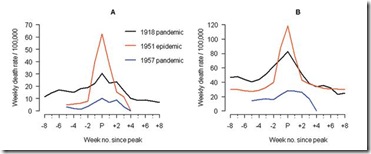
#16,869
With the COVID crisis now well into its 30th month, and showing no signs of abating, many are wondering just how long this pandemic can last. Prior to COVID, `conventional wisdom' - based primarily on the 1918 pandemic - held that a severe influenza pandemic could come in multiple waves over as many as 18 months.
But some pandemic planners have been far more optimistic.
An influenza pandemic affects between 30% and 50% of the population. If 30% of South Carolina’s population were stricken by a pandemic, 1,200,000 would seek medical assistance and up to 17,000 would need hospital care. There could be from 2,000 to 5,000 deaths, and the effects of a pandemic would last six weeks or more in a community.
According to the latest data, South Carolina's COVID death toll has now passed 18,000.
In fairness, most of the federally mandated pandemic plans that year assumed a `mild or moderate' pandemic, often anticipating a fraction of the impact of what the CDC/HHS was expecting. In 2007's Wishing on a Czar, we looked again at this huge disparity between jurisdictions.
(Note: the scale of these two graphs are different)
The two main spikes of 1918 and 1919 are readily apparent, but as you can see, there were significant increases in P&I mortality rates in 1922, 1923, 1926, and 1929. Nothing to compare with the 1918-1919 outbreaks of course, but significant if you were caught up in one.
Still, it is quite evident that the 1918 Spanish flu wasn't `over' by the summer of 2020.
By contrast, the 1930’s and 1940’s were especially quiescent when it came to Pneumonia and Influenza mortality, even during the 2nd world war.
The next `official' pandemic - the `Asian Flu’ of 1957 - is generally thought of as coming in 2 waves, spanning from about October of 1957 to April of 1958. But a look at the pandemic waves associated with the Asian flu shows that significant spikes in P&I (Pneumonia and Influenza) mortality continued until 1963.
All of these examples have stemmed from influenza viruses, with major strain changes coming infrequently (1918, 1957, 1968, 2009, etc.).
Coronaviruses typically leave behind less permanent immunity than influenza, as explained in Fenner and White's Medical Virology (Fifth Edition - 2017),:
The typical coronavirus “common cold” is mild and the virus remains localized to the epithelium of the upper respiratory tract and elicits a poor immune response, hence the high rate of reinfection. There is no cross-immunity between human coronavirus-229E and human coronavirus-OC43, and it is likely that new strains are continually arising by mutation selection.
Just as we've seen with seasonal influenza, COVID waves are likely to continue for the foreseeable future. Some waves may be mild, while others perhaps not so much.
While we discussed it at length in Remembering 1951: The Year Seasonal Flu Went Rogue, there is historical precedent for seeing an unusually deadly wave of influenza emerge, even during an otherwise mild non-pandemic year.
The winter of 1950-1951 had been an average flu year, with the dominant flu called the `Scandinavian strain', which produced mild illness in most of its victims. In fact, if you look at a graph of flu activity for the United States, running from 1945 to 1956, you'll see nary a blip.

But in December of 1950 a new strain of virulent influenza appeared in Liverpool, England, and by late spring, it had spread across much of England, Wales, and parts of Canada.
The following comes from an absolutely fascinating EID Journal article: Viboud C, Tam T, Fleming D, Miller MA, Simonsen L.
The 1951 influenza epidemic (A/H1N1) caused an unusually high death toll in England; in particular, weekly deaths in Liverpool even surpassed those of the 1918 pandemic. . . . . Why this epidemic was so severe in some areas but not others remains unknown and highlights major gaps in our understanding of interpandemic influenza.
According to this study, the effects on the city of origin, Liverpool, were horrendous.
In Liverpool, where the epidemic was said to originate, it was "the cause of the highest weekly death toll, apart from aerial bombardment, in the city's vital statistics records, since the great cholera epidemic of 1849" (5). This weekly death toll even surpassed that of the 1918 influenza pandemic (Figure 1)
For roughly 5 weeks Liverpool saw an incredible spike in deaths due to this new influenza. And it didn’t just affect Liverpool. While it appears not to have spread as easily as the dominant Scandinavian strain, it managed to infect large areas of England, Wales, and Canada over the ensuing months.
Getting started relatively late in the flu season, this new strain never managed to spread much beyond UK and Eastern Canada. Nor did it reappear the following flu season. It simply vanished as mysteriously as it appeared.
But it should remind us that viruses are unpredictable, and we can't afford to always assume the `best-case scenario'.
Hopefully, over time, COVID will slow its mutation rate, which should help updated vaccines and acquired immunity to reduce its impact. But unless and until that happens, COVID is unlikely to go gently into the night.
Until then, I would take any `estimates' of when this pandemic will be over with a very large grain of salt.
(Editor's note: The original link to the Public Health Monograph No. 48, 1957 is no longer active. I was able to find these same graphics referenced in a 2015 article on the 1918 pandemic: https://www.history.navy.mil/research/library/online-reading-room/title-list-alphabetically/i/influenza/the-pandemic-of-influenza-in-1918-1919.html) and in a CDC publication from 1960: The Epidemiology of Asian Influenza 1957-1960.)




